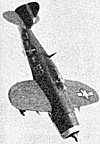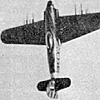 Air war games, potentially, appear to be among the most fascinating types of war game. The
aircraft of World War I and World War II, for the modeller, are among the last of weapons to appear with personal, national, and unit markings varied and bright as cavalry guidons or knightly coat of arms. In addition, the tactical and strategic scope of military aviation,
for the board or table top commander, offer tempting possibilities.
Air war games, potentially, appear to be among the most fascinating types of war game. The
aircraft of World War I and World War II, for the modeller, are among the last of weapons to appear with personal, national, and unit markings varied and bright as cavalry guidons or knightly coat of arms. In addition, the tactical and strategic scope of military aviation,
for the board or table top commander, offer tempting possibilities.
Nationally, all manner of board and table top rules have been attempted to provide for the use of airplanes in war games, and some purely aerial games ("Battle of Britain" - Gamescience, and "Dogfight" - Milton Bradley, for example) are on the market. Don Featherstone ("Wargamers Newsletter," Southampton, England) has even published a book on the subject (Air War Games) which provides a fairly thorough resume of concepts related to the use of model airplanes in games.
Unfortunately, although the board games cited have their good points, and Featherstone's work provides a great deal of interesting philosophical speculation, air war games remain the most elusive of war games to deal with, for a variety of reasons.
For the table top war gamer problem number one is that air planes, picturesque though they may be, do not naturally remain in position, as do tanks, guns, and foot soldiers, when moved and during the resolution of combat. Much of the appeal of the table top game is the appearance of a changing diorama, with pieces occupying their relative positions at the end of each move. Pick up a cavalry unit and place it against the infantry unit it is charging-presto, a diorama of sorts. Pick up your airplane, place it over the unit it is dive bombing, and leave it there ... thunk, you have a broken plastic airplane sitting on a cracked tank.
Best solution I have seen is to mount the airplane loosely on a wire rod, mounted in a weighted base, with a movable clip holding the airplane up. Most air war games, however, are probably conducted with hand held models which diminishes interest in the game.
Problem Number Two
A second problem, which afflicts board games as well, relates to the first. Altitude is a crucial variable in both air to air and air to ground combat.
During World War II, air combat took place anywhere from approximately sea level to around 40,000 feet up. Not only was the above and behind position strongly favored for fighters, but a fighter (once at 10,000 feet would have difficulty intercepting an incoming raid at 20,000 feet or tree top level. Flak batteries, too, have a variable effect at different altitudes. Light automatic cannons or machine guns are far more effective than heavy flak weapons against fighters or dive bombers on tactical low level missions, but progressively useless as the altitude goes up.
Perhaps more confusing is the role of technology. War games must for the most part offer both players some chance of some sort of victory, but in an air war the rival technologies have as a primary mission the establishment of an unsurmountable supremacy before the "battle". By penalizing a model of an inferior aircraft, rules will severely hamper the normal model collector's urge; and by providing rules which hinder one player technologically, the game can be over before it starts.
Nowhere, even in armored warfare, has technology so dramatically affected the conditions of battle as in air to air combat.
With these problems in mind, I am presenting my own prejudices and suggestions on air war game rules with the expectation of comments from readers who have tangled with the same difficulties.
FLAK EFFECT
- light flak single weapon 11, 12 - 40" low
light flak double or multiple 10, 11, 12 - 40" low
medium flak single weapon 10,11,12 - low, medium up to 80"
double or multiple 9,10,11,12 - medium
heavy flak single weapon upto300" 11,12 high , 10, 11, 12 medium
Allow a hit on 1 score lower against fighters in a strafing or bombing pass at optimum attack speed.
Allow a hit on 2 scores lower for a dive bomber or liaison aircraft.
Against bombers actually committed to a bomb run allow 2 scores lower at medium or high altitutde.
Three ground mounted heavy machine guns or touch mounted heavy machine guns may be classed as one light flak weapon when they are within 30" of the flight path of an airplane.
Air to Ground Action
A dive bomber may drop all or part of its load in a pattern gauged by a 6" spread crossing at 3" with two dice being rolled, one for windage, the other for elevation. Burst as for heavy or medium shell.
A fighter bomber drops bombs in a pattern with 6" windage, 12" elevation (line of flight).
A level bomber drops with 6"x18" (line of flight), add 6" to spread in either direction at medium altitude, another 6" to spread in either direction at high altitude.
Machinegun fire may hit a vehicle with a 5-6, troops with a 6", one die for each pair of machineguns. Strafing either stops the enemy infantry for one turn or the infantry drops down to a 3-4-5-6.
Air to Air Combat
The basic air to air weapon is the single seat single engined fighter.
When two opposing fighter squadrons meet head on at near equal altitude the following scores are required to hit:
- Stern attack against evading fighter 10-11-12
Stern attack fighter attacking another target 9-10-11-12
Frontal attack 11-12
Side attack 11-12
 The patrol altitude and direction of aircraft must be noted by the
player on paper, and announced to the enemy if the aircraft are within 25 miles
of a radar installation of the enemy, and are at high or medium altitude. Aircraft
will be presumed sighted at 2 air miles by air units or ground observers if
vision of the latter is not obstructed.
The patrol altitude and direction of aircraft must be noted by the
player on paper, and announced to the enemy if the aircraft are within 25 miles
of a radar installation of the enemy, and are at high or medium altitude. Aircraft
will be presumed sighted at 2 air miles by air units or ground observers if
vision of the latter is not obstructed.
Approach speed to the tactical board is at 1 mph per 1", or, for example, 300" at 300 mph. Fighter aircraft may ascend 1,000 or descend 4,000 ft. with forward motion cut to 1/3rd.
Fighter aircraft are presumed able to make 280 mph cruising, 350 maximum.
Dive bombers 180 - 250 mph
Light, medium & heavy bombers 250 - 300 mph
Fast bombers (if used) 300 - 350 (Reconnaissance, without
bombs, 330 loaded).
Climb rate in proportion.
Bombers operate with full load at 1/3rd radius, 2/3rds, load at 2/3rds radius, 1/3rd at full radius. Fighters may be in combat zone on the same basis.
Radius - Fighter, Dive bombers (loaded) 270
Light or Medium Bomber 400
Heavy Bomber 600
Fighter, belly tanks instead of bombs 400
Altitude advantage (if it cannot be budged during the attack turn) confers 1 free pass or adds 1 score if the enemy climbs to meet the attack.
Twin engined fighters are presumed of equal speed and climb to single engined fighters, 1-5 times the single engined fighters load, light bomber range (heavy bomber w/tanks) and dive bomber maneuverability.
Maneuverability is as follows:
- Fighter - Dive bomber - Light bomber - medium bomber
heavy bomber.
For each degree of superior maneuverability over its opponent a fighter may execute one free tail pass per 3 dogfight turns. Heavy fighters may avoid this by entering a defensive circle or, if over 5,000 ft., by diving and leaving the combat area for 3 turns.
Defensive fire from bombers
Bombers may fire flexible machineguns as single light flak weapons, power turrets as multiple light flak weapons. A standard heavy, medium, and light bomber should be used as the pattern with heavier and lighter armed bombers costing more or less at 5 points per machinegun.
Standard points
- Dive bomber = 20 pts.
fighter = 35 pts.
twin-engined fighter = 50 pts.
light bomber = 50 pts.
medium bomber = 50 pts.
heavy bomber = 125 pts.
One hit will disable a single engine aircraft, 2 a twin engine aircraft, etc.
Biplane fighters may be employed which move as a dive bomber but, if engaged in a dog fight, score a fire pass every other turn on normal fighters, and are 1 point harder to hit if attacked in rear or side.
Conduct of Air to Air Combat
After jockeying for position and approaching any fighter aircraft or unit may initiate action by committing itself towards the enemy aircraft. Counter moves will be considered as
- a. counter attack, two head on passes, with or without altitude
advantage.
b. Evasion. Aircraft of equal speed may evade a rear attack by diving or level flight, but the attacker may remain behind on the following turn, and will be able to stage a rear attack without return fire on the second move if he has a diving attack.
Evasion by maneuver drops the attackers firing ability by one, but gives no return fire.
If both players wish to continue a "dogfight" the two groups of fighters are simply set aside and each plane takes one shot per turn (if equal).
Twin engined fighters, or monoplanes engaging biplanes, may wish to dive or run through, sacrifice one turn, and come back for another pass.
For attacks on bombers add 2 to the effective score, i.e., if 10-11-12 hits, 8-9-10-11-12 will hit.
All bombers in a formation of up to 4 aircraft may fire all guns that bear at attacking fighters. Coupled bombers lose 25 mph per hit and must be abandoned or slow down the formation.
Frontal attacks may knock down a bomber with 2 hits if the attacker specifies aim at the pilot and co-pilot.
Back to The Armchair General Vol. 1 No. 3 Table of Contents
Back to The Armchair General List of Issues
Back to MagWeb Master Magazine List
© Copyright 1999 by Pat Condray
This article appears in MagWeb (Magazine Web) on the Internet World Wide Web. Other military history articles and gaming articles are available at http://www.magweb.com
